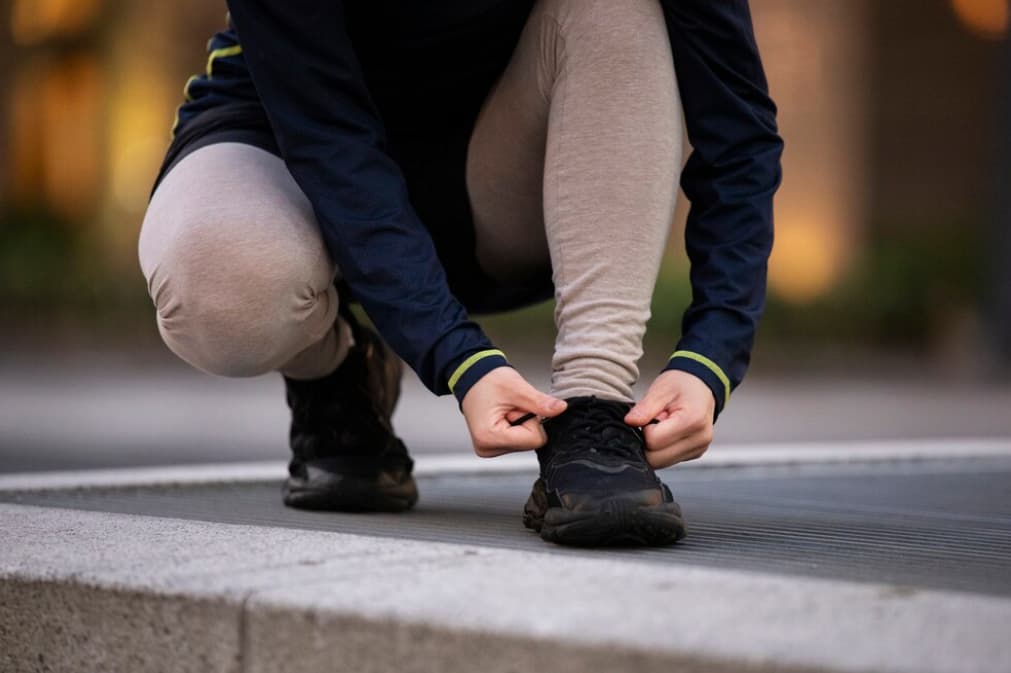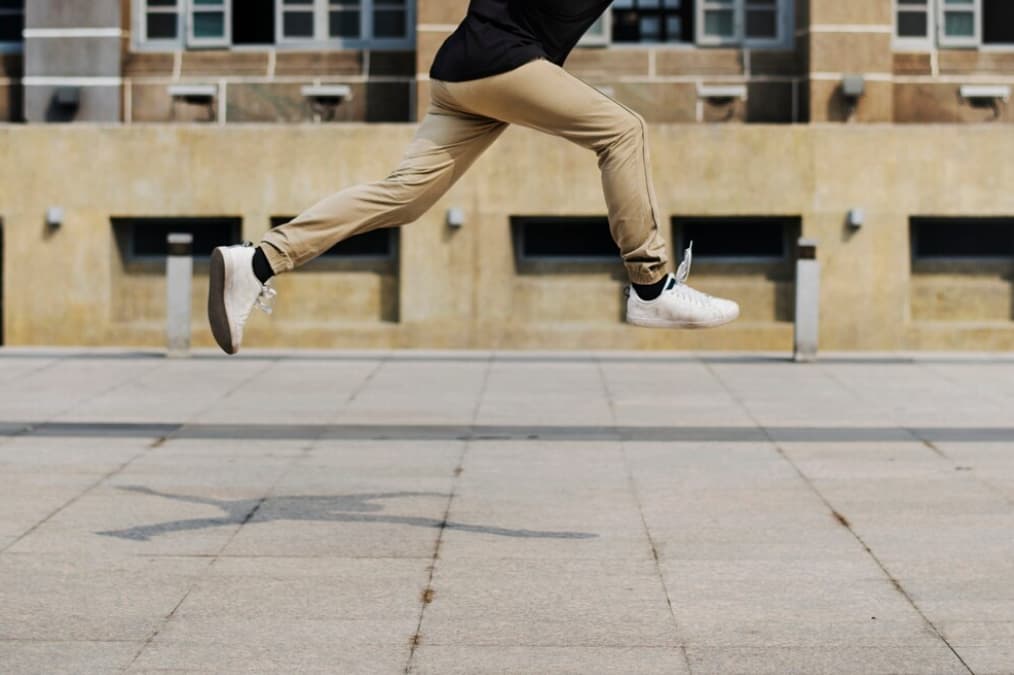Today, we’ll delve into the optimal footwear choices for parkour training. Selecting the appropriate shoes is crucial in this context. Sporting unsuitable footwear can lead to various challenges, such as slipping during wall runs and rail precisions, suffering from bone bruises due to intense impacts, diminished foot sensitivity impacting balance, feeling weighed down and reducing jump height, or in severe cases, weakening the feet, adversely affecting alignment, and potentially causing a host of issues with the ankles, knees, and back.
While exploring the world of parkour footwear is essential for enhancing performance and safety, it is equally crucial to consider the potential risks associated with the sport, as discussed in the article about parkour injuries.
Barefoot vs. Shoe Training: Fitness Footwear Comparison
In the fitness world, including parkour circles, there’s a growing trend towards barefoot training. But do forgoing shoes, even those specifically engineered for performance enhancement, truly benefit our feet? The answer lies in a balance of both advantages and disadvantages.
Barefoot training excels in improving foot alignment, enhancing sensory feedback, and strengthening the feet. It aligns with the body’s natural design, capable of enduring more stress and activity than commonly assumed.
However, the drawback is that many of us have underdeveloped feet from a lifetime of shoe-wearing, leading to soft, weak feet ill-prepared for rough surfaces, high stress, or intense impacts. For most, transitioning to barefoot training, especially in demanding activities like parkour, could take years and might increase injury risks. Conversely, the right footwear can offer better grip and allow for more intense training.

But, shoes also have their pitfalls. They can act like a cast, leading to muscle atrophy in the feet, disrupting natural alignment, and potentially causing cascading issues throughout the body. The optimal approach is to blend both barefoot training and the use of well-designed shoes. This strategy allows gradual foot strengthening while still enabling more ambitious moves and training on challenging terrains that require the support of shoes.
For example, during light training, going barefoot or using a “barefoot” shoe is a common choice. However, for heavy impact training that requires extra support for the feet, opting for a good running shoe is advisable.
Typically, two pairs of shoes are recommended:
- A minimalist shoe that offers a barefoot feel. This includes features like no cushion, a wide toe area allowing toes to spread out and move, no extra ankle support, and a soft sole and body for flexibility and movement with the foot;
- A heavy impact shoe designed for extra support. This type of shoe usually has a nice cushion, a tighter fit, and a harder sole and body for better resistance.
Crucial Considerations for Selecting the Right Footwear
- Steer clear of footwear with plastic on the soles or arches. Plastic elements can lead to slippage, especially on precarious surfaces like rails;
- Opt for lightweight footwear over heavy and bulky designs. The added weight can hinder movement and agility;
- Skate shoes are not recommended for certain activities. Despite their popularity, they may not provide the necessary support or functionality for specific types of training or activities;
- Choose shoes with secure fastenings, like laces. Shoes without proper fastening mechanisms can lead to a lack of stability and an increased risk of injury;
- Select shoes with a solid, single-piece sole. Soles made up of multiple pieces are prone to quicker wear and tear, reducing the shoe’s overall durability and effectiveness.
Essential Features in High-Performance Footwear
- Prioritize footwear with exceptional grip. This is crucial for activities like wall climbing, balancing on narrow surfaces, and ensuring overall traction during diverse movements;
- Seek a balance between lightweight construction and adequate support. The ideal shoe should combine lightness for agility with sufficient cushioning for comfort and foot protection;
- Emphasize comfort. Shoes that feel good on the feet enhance performance and reduce the risk of discomfort or injury during extended use;
- Consider footwear with enhanced sensitivity. Shoes that allow for a better feel of the surface can improve precision and control in various activities.
Optimal Footwear Selection for Various Experience Levels
For beginners, it’s advisable to start with shoes that offer more cushioning and have a somewhat stiffer structure. This choice is beneficial as initial training often involves developing form, and a more forgiving shoe can accommodate less refined techniques.
Conversely, for those with more experience in activities like traceur, or for those focusing on low-impact moves and flow, shoes that provide greater sensitivity and flexibility are recommended. These types of shoes may offer less cushioning than stiffer options, but they enhance balance and control, aid in achieving higher jumps, and contribute to foot strengthening and improved overall alignment. They are particularly effective for activities requiring precise footwork, such as ground flips.
Footwear Trends in Movement-Based Sports Communities
Observations within the parkour and freerunning (PK FR) communities indicate certain footwear preferences among practitioners. Seasoned and highly skilled individuals often opt for shoes like Feiyues or similar brands known for their flexibility and sensitivity. For high-impact activities, they might choose Kalenjis or other budget-friendly running shoes.
Advanced practitioners, who train frequently and therefore wear out shoes rapidly, tend to avoid expensive options. The exception is those with sponsorships, who naturally wear shoes provided by their sponsors. In contrast, beginners or less experienced members often invest in high-end freerunning-specific shoes. However, these expensive options don’t necessarily offer significant advantages, particularly when considering their cost.
Guide to Versatile Footwear Options

Here is a range of popular footwear choices, each suited for different needs and preferences. It’s a starting point to explore and find the ideal pair based on individual requirements.
Minimalist Shoes:
- Vibram 5 Fingers: Known for its unique design with individual toe slots. They’re a favorite for some, though not universally due to their distinct appearance and varying support levels;
- Feiyues: Highly regarded for activities requiring flow and agility. Affordable and stylish, they have a spacious toe area but may wear out quickly with intense use;
- VIVOBAREFOOT (Aqua Light and Neo): Recommended by experts, these offer a durable sole and a great minimalist feel, though they come at a higher price point.
Heavy Impact Shoes:
- Kalenji: Known for their quality, these recently reintroduced shoes have garnered positive feedback;
- Five-10s;
- K-swiss Arayiaki: They receive mixed reviews, with some questioning their value for money;
- Reebok Free;
- Nike Dart;
- K-Os: An affordable option, though experiences vary with durability;
- Budget-friendly running shoes from brands like New Balance, Asic, and Saucony are also worth considering.
This list is not exhaustive but serves as a helpful starting point. More options will be added to cater to the diverse needs of parkour enthusiasts and others seeking functional and comfortable footwear.
Conclusion
Having the right parkour shoe is a critical aspect of your training experience. Whether you choose to train barefoot or with shoes, or even a combination of both, the primary goal should be to ensure your feet are adequately protected and capable of withstanding the physical demands of parkour. Always prioritize comfort, grip, support, and durability while selecting your footwear. The ultimate choice of shoes will significantly contribute to your performance, foot strength, and overall parkour experience.